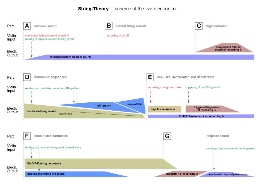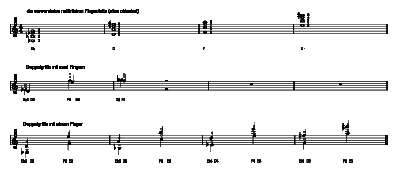String-Theory
- for violin and live-electronics
- Duration: approx. 13 min.
- world premiere at GRIM, Marseille, 2005
performances
String-Theory was commissioned by Lenka Župková for our concert program violin and electronic.
The piece was premiered at the festival "Nuit d'hiver #3" in December 2005 at the GRIM Marseille with Lenka Župková on the violin.
Other performances:
April 2006 in Kiew, organized by Goethe-Institut Kiew, as well as in Odessa at the festival "2 days and 2 nights of new music", ANM Ukraine.
June 2006 in Weimar as part of my portrait concert at the Musikhochschule "Franz Liszt".
March and April 2007 during a concerts tour in the Czech Republic (Pardubice, Prague, Opava).
November 2007 in our concert during the Miso Music Portugal Season 2007 at the Instituto Franco-Português in Lisbon.
String-Theory has been released at Lenka Župková's CD "Prague/Hannover" by Schott/WERGO.
media
Video recording of the premiere at the GRIM, Marseille:
 |
 |
||
| graphical score with electronics | all harmonics and harmonics double stops |
demo recording (violin - Lenka Župková, electronics - Andre Bartetzki):
impulse sounds on the four free strings:
program notes
The string theory is an attempt to explain all of the particles and fundamental forces of nature in one theory by modeling them as different patterns of multi-dimensional vibrations of tiny supersymmetric strings.
Our physical space is observed to have only four large dimensions, but nothing prevents one from having more than 4 dimensions, per se. In the case of string theory, consistency requires spacetime to have 10, 11 or 26 dimensions. The conflict between observation and theory is resolved by making the unobserved dimensions compact dimensions. One way of dealing with higher dimensions is to not try to visualize them at all but to just think of them as extra numbers in the equations that describe the way the world works.
Only a few millimeters away from our 4-dimensional world many parallel universes might exist.
realization notes
The violin has a scordatura on two strings: Eb (G-string 4 semitones down), D (normal), F (A-string 4 semitones down), E (normal). So that the empty strings form the chromatic sequence D-Eb-E-F if we disregard the octaves and the order. If the strings are tuned like this it is easier to play 11 of the 12 notes of the whole chromatic scale by the lower natural harmonics (octavs, fifths, thirds).
Base intervals of this composition are the semitone (1 step) and the major seventh (11 steps). The violin plays almost only two different type of sounds: natural harmonics (as single and double stops) as well as ultra short impulses which are produced by only minimal bow movements with very hard pressure. Both type of sounds – harmonics and impulses – can be regarded as elementary, atomic parts of the violin sound: harmonics are parts of the harmonic series of a vibrating string whereas the impulses represent a single short time period of the bowing action. They are so to speak spectral and temporal details of a normal violin sound.
For this piece these 2 sound types were structured and organized by simple algorithmical models in 3 major parts. During the performance the noises and sounds of the violin are extended and processed by means of various live-electronic treatments, which are partly also based on simple structural models. The electronic processing was realized as a patch in the programming language SuperCollider 3. All processings have multichannel outputs for a variable number of speakers (ideally: 4, 6 or 8).